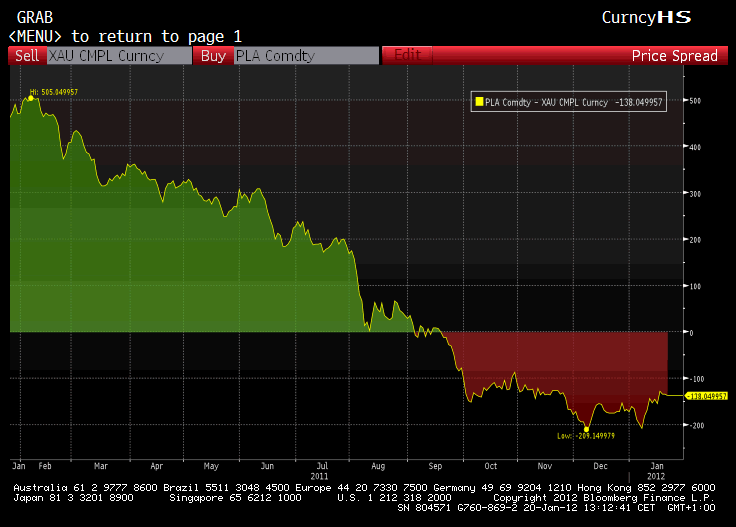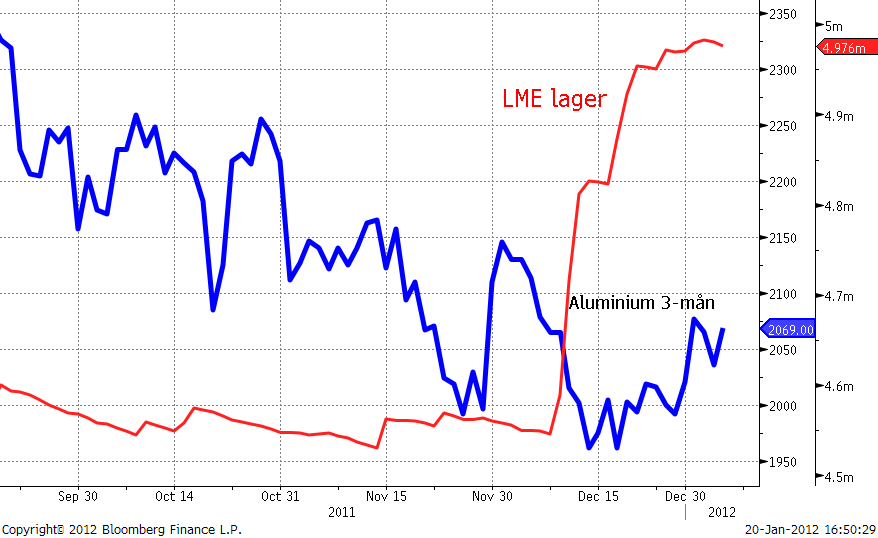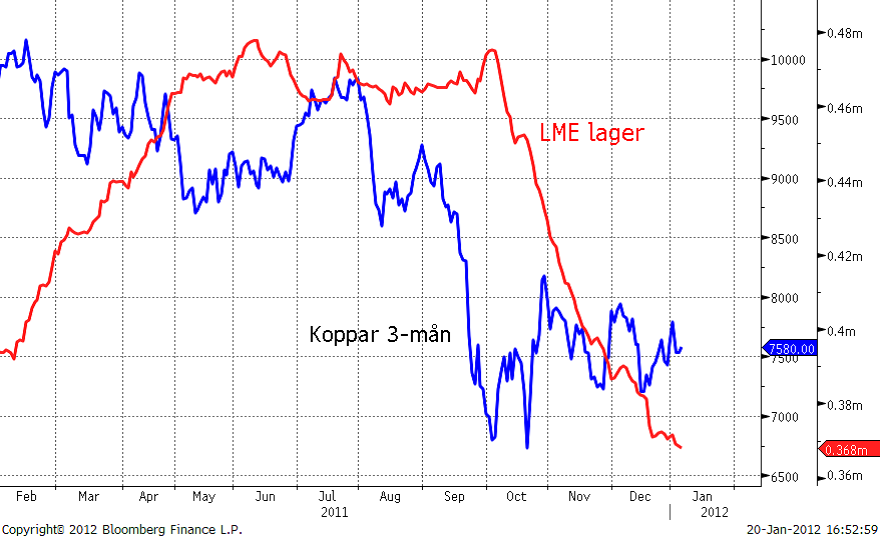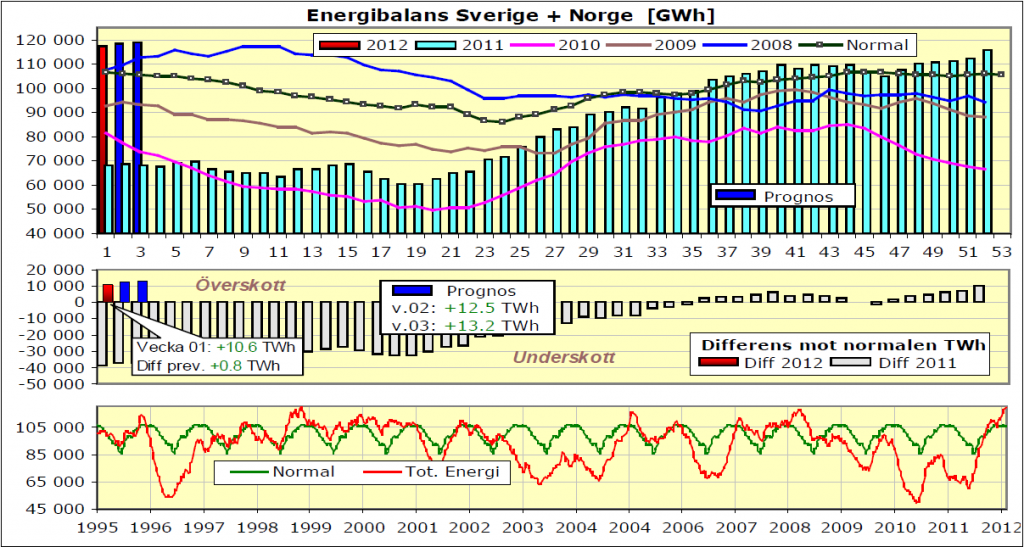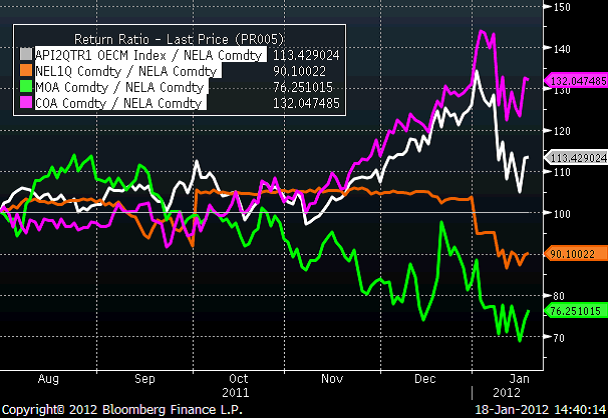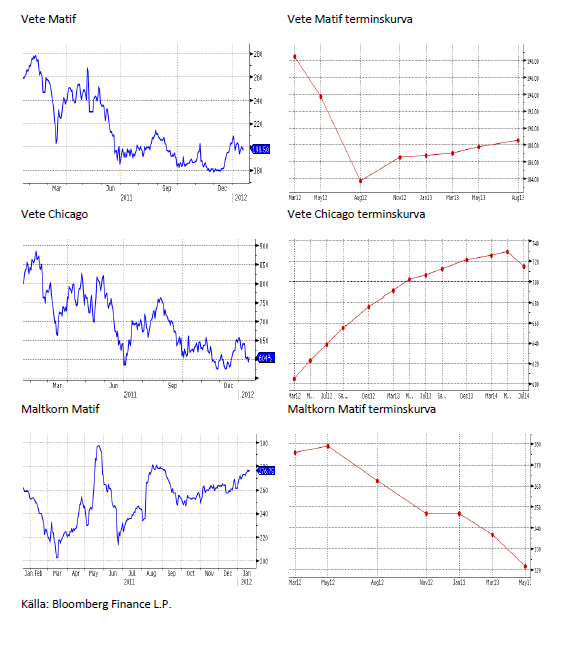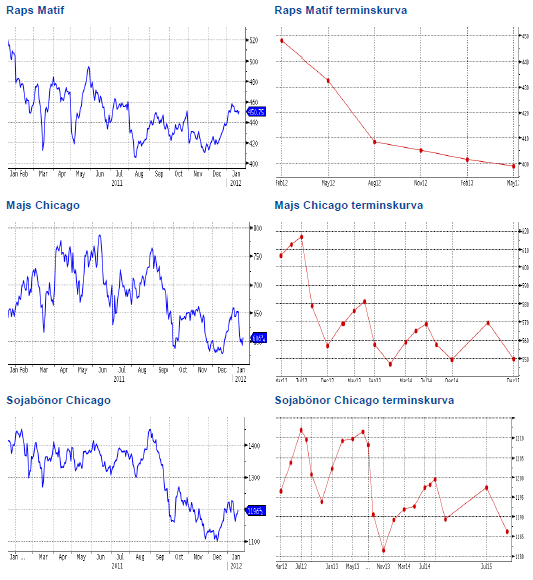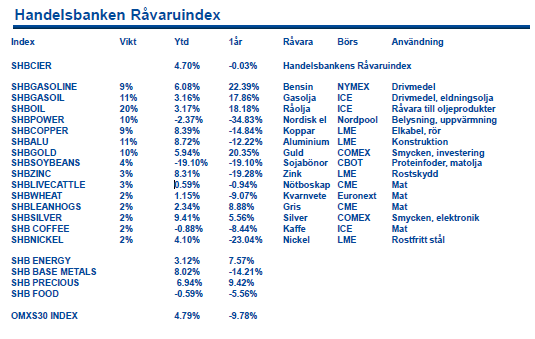Analys
SHB Råvarubrevet 20 januari 2012
 Veckan har präglats av positiva nyheter vilket har varit positivt för flera tillgångsklasser. De positiva nyheterna har kommit från USA (arbetslöshet och nyhusförsäljning), Grekland (mindre skuldavskrivning än väntat för privata investerare) och Europeiska centralbanken (de treåriga lånen till bankerna har börjat få avsedd effekt). Aktiebörserna har varit starka, exempelvis har S&P 500 inte gått upp så mycket i början året sedan 1987. Statsräntorna i flera länder har gått ned, exempelvis har Italiens 10-årsränta gått ned 35 punkter. Vårt råvaruindex har gått upp med 1.94% under den senaste veckan. Det är främst metaller som fungerat som draglok för uppgången.
Veckan har präglats av positiva nyheter vilket har varit positivt för flera tillgångsklasser. De positiva nyheterna har kommit från USA (arbetslöshet och nyhusförsäljning), Grekland (mindre skuldavskrivning än väntat för privata investerare) och Europeiska centralbanken (de treåriga lånen till bankerna har börjat få avsedd effekt). Aktiebörserna har varit starka, exempelvis har S&P 500 inte gått upp så mycket i början året sedan 1987. Statsräntorna i flera länder har gått ned, exempelvis har Italiens 10-årsränta gått ned 35 punkter. Vårt råvaruindex har gått upp med 1.94% under den senaste veckan. Det är främst metaller som fungerat som draglok för uppgången.
Ädelmetaller
Veckouppgången för guld hamnade på drygt 1 %. Den fysiska marknaden för guld har präglats av låg aktivitet på grund av det kinesiska nyåret. Vi har en försiktig syn på guldprisets utveckling framöver. De faktorer som dragit upp guldpriset till dessa nivåer kvarstår; låga reala räntor, oro för skuldkrisen i Europa och oro för att stater ska inflatera bort sina skulder genom att tillåta en högre inflation. Vi tror dock att de något bättre utsikterna för främst den amerikanska ekonomin samt att guldpriset den senaste tiden visat bubbeltendenser väger starkare i vågskålen.
Platina har gått upp 1.3% denna vecka, den tredje veckan på raken med en uppgång. Palladium används i katalysatorer till bilar, främst dieselbilar. Den senaste nyhetsutvecklingen från Europa har präglats av försiktigt positiva nyheter och detta skulle i förlängningen betyda en ökad nybilsförsäljning.
Ovanstående bild visar relationen mellan guld och platina. Platina har varit billigare än guld sedan september 2011.
Silver har gått upp drygt 2.7% i veckan. Efterfrågan från industrin har pressat upp priset den senaste tiden samtidigt som det har kommit rapporter om förnyad efterfrågan i konsumentled, främst från Indien. Vi har sett intresse från våra kunder att säkra priset på dessa nivåer (via optioner).
Olja
Våra oljeanalytiker har reviderat upp bankens officiella oljeprognos med 15 dollar till 105 dollar för år 2012, 110 dollar för 2013 och 115 dollar för 2014. Det är främst risken på utbudssidan och den geopolitiska oron som mer än väl kompenserar för risken för minskad efterfrågan och global tillväxt. Vi förväntar oss vidare att OPEC kommer att försvara denna högre prisnivå som ett resultat av högre budgetkrav än tidigare.
Noterbart är att fallet på fraktmarknaden fortsätter och Baltic Dry Index har nu halverats sedan mitten av december och noterades i veckan under 1000 för första gången på 3 år!!. Det är främst dåligt väder i Australien, Brasilien och Colombia som bromsat befraktningen av järnmalm, dvs en större utbud av Capesize har funnits tillgänglig. Vidare är efterfrågan från Kina och tillväxtländerna säsongsmässigt svag inför årsskiftet samtidigt som man ganska sent in på året betade av ytterligare lager för att frigöra kapital. Även om efterfrågan varit något lägre än väntat tror vi dock att det största problemet på fraktmarknaden är en massiv överkapacitet vilket är ett problem marknaden kommer att tvingas dras med under en lång tid framöver, det kommer med andra ord dröja innan man kan använda fraktindex som ledande signaler för att tolka sentimentet.
Basmetaller
Basmetallerna har haft en stark start på det nya året. Den största uppgången noteras för zink och aluminium som båda stärkts med över 9 % sedan årets början. Under årets första veckor har flertalet av världens största aluminiumproducenter annonserat att de drar ned på produktionen som ett resultat av fallande priser under slutet av 2011. I raden av dessa ställer sig Rio Tinto, världens nästa största producent, Alcoa, världens tredje största samt Norsk Hydro som är världens femte största producent. Samtidigt ökar produktionskapacitet i Kina och mellanöstern vilket kan för framtiden kan tyda på ett för stort utbud. Samtidigt som priserna stärks stiger LME:s lager för aluminium som nu överstiger för första gången någonsin 5 miljoner ton.
Även koppar hade en stark vecka, med fallande lager och en svagare dollar kunde metallen stärkas med 4,4 % sedan måndagens öppning. Freeport McMoRans koppargruva i Grasberg har kommit igång med produktion och leveranser efter den tre månader långa strejk som avlutades i december. Gruvan i Grasberg är världens näst största koppar- och guldgruva som trots strejken stod för cirka 2,5 % av kopparproduktionen under 2011.
El
Andra kvartalskontraktet har tappat närmare 9 procent sedan årsskiftet till följd av den milda och nederbördsrika väderleken som aldrig verkar vilja försvinna. Energibalansen har förbättrats rejält, under december månad fick Norge och Sverige sammantaget över 22 TWh nederbördsenergi vilket är 6 TWh över normalt!. Vi noterar även att Svensk vindkraft producerade 6.1 TWh under 2011 vilket är en ökning med 74 procent och för första gången mer el än från en genomsnittlig svensk kärnkraftsreaktor. Totalt sett förväntas elproduktionen från den svenska vindkraften inom kort svara för över 5 procent av elanvändning i Sverige. Samtidigt som det våta vädret håller i sig har temperaturnivån legat 2-3 grader över normalt vilket medfört en svag last och ytterligare förbättring av energibalansen. Med de senaste prognoserna ser det därför ut som om vi kommer ha ett överskott om ca 12 TWh efter helgen vilket kan jämföras ett underskott om ca 40TWh vid samma period förra året.
Vidare har energikolet (APi2 kvartal i vitt nedan) tappat 6.3 procent sedan årsskiftet och svenska kärnkraften gått på över 80 procents kapacitetsutnyttjande vilket gör att det är svårt att motivera en uppgång under dessa premisser. Det rådande energiläget är gynnsamt och dämpar volatiliteten helt klart och det krävs en kraftig förändring i någon av de ovan nämnda faktorerna för att elpriserna skall börja röra på sig. Bilden nedan visar elpriset (orange), utsläppsrätter (grön), brentolja (rosa)
Vete
Terminspriser på vete Matif stängde igår på en något högre nivå jämfört med förra veckan, medan vetet i Chicago noteras i stort sett oförändrat. Skörden i Australien är nu klar, tur det kanske för det uppges finnas lite lagringsutrymme kvar som följd av den stora skörden. Även i Argentina är skörden avklarad och fokus där kommer nu riktas på väder vid sådd. Fortsatt inga skäl till oro för det europeiska höstvetet. Det amerikanska höstvetet har dock fått uppleva lite lägre temperaturer vilket inte är bra då det finns lite skyddande snö, men än så länge inga extrema temperaturer. Som vi rapporterat om flera gånger tidigare är det ukrainska höstvetet i dåligt skick, nu rapporteras om att endast 82 procent av höstvetet ens grott. Vetet i både USA och Ukraina lär behöva en hel del regn till våren. Att vetet inte är i bästa skick är dock marknaden redan medveten om, för högre priser måste vi se bekräftat större skador än väntat eller fortsatt torka i Sydamerika med stigande priser på majs som drar med sig vetet. Under veckan har bland annat Strategie Grains och IGC, likt USDA i förra veckan, justerat upp sina förväntningar på utgående lager av vete säsongen 2012/13 – vilket väntas bli det största någonsin. Fortsatt ökande vetelager i kombination med stor majsareal till våren i USA bör ge lägre priser längre fram under året.
Raps
Terminspriset på raps har gått ned något sedan förra veckan, utan några större nyheter men delvis som följd av vinsthemtagning efter den senaste tidens uppgång. På grund av fortsatt hög efterfrågan och bristfällig tillgång på raps i EU väntas rapspriserna bli kvar på en relativt hög nivå under ett ganska bra tag. Viss korrektion nedåt efter uppgången i mitten av december ser dock kanske mer trolig ut än en närstående prisuppgång – vilket gör att en prissäkring på dagens nivåer bör ses som attraktiv. Fortsatt varmt och torrt väder i Sydamerika, med stigande sojapriser som följd, kan dock driva upp rapspriset ytterligare något.
Maltkorn
Terminspriset på maltkorn har stigit något sedan förra veckan. Inga större nyheter har nått marknaden under veckan men viss oro finns för att resultatet av grobarhetstester i Danmark ger negativa besked – resultatet redovisas i nästa vecka. Om testerna visar att det inte är några större problem med danskt maltkorn finns det en hel del mer maltkorn tillgängligt för den europeiska marknaden än befarat och priserna bör således falla tillbaka något. Negativt resultat från testerna bör leda till det motsatta – stigande priser. Från dagens höga nivå bör dock uppsidan ses som något begränsad. Under veckan har våra kunder kunnat prissäkra delar av årets maltkornsskörd på omkring SEK 2,17/kg – en klart attraktiv nivå.
Majs
Majsen i Chicago har gått ned i pris sedan förra veckan, främst som följd av viss nederbörd i torkdrabbade Argentina. Ökat intresse för amerikansk majs på exportmarknaden de senaste dagarna har dock gett visst stöd, bland annat uppges Sydkorea ha köpt 230.000 ton majs från USA. Prisutvecklingen under den närmaste tiden kommer vara starkt påverkad av den fortsatta väderutvecklingen i Sydamerika – en del väderprognoser lovar regn medan andra utlovar fortsatt torrt och varmt väder under kommande två veckor så situationen är klart svårbedömd och osäker.
Sojabönor
Sojapriserna i Chicago har visat styrka och stigit i pris sedan förra veckan. Precis som för majsen kommer prisutvecklingen för sojabönorna den närmaste tiden vara väldigt beroende av vädret i Sydamerika under kommande veckor, vilken alltså är väldigt svårbedömd. Priset på sojabönor har tidigare i veckan backat något som följd av viss nederbörd i Sydamerika, men pressats upp igen senare under veckan på grund av rykten om att Kina köpt relativt stora volymer amerikansk soja. Eventuellt fortsatt dåligt väder i Sydamerika kommer pressa upp sojapriserna ytterligare, dessutom menar flertalet analytiker i Sydamerika att USDA i förra veckans WASDE-rapport överskattar den kommande sydamerikanska skörden med så mycket som 8-10 miljoner ton.
Prisutveckling och terminskurvor
Handelsbankens Råvaruindex
[box]SHB Råvarubrevet är producerat av Handelsbanken och publiceras i samarbete och med tillstånd på Råvarumarknaden.se[/box]
Ansvarsbegränsning
Detta material är producerat av Svenska Handelsbanken AB (publ) i fortsättningen kallad Handelsbanken. De som arbetar med innehållet är inte analytiker och materialet är inte oberoende investeringsanalys. Innehållet är uteslutande avsett för kunder i Sverige. Syftet är att ge en allmän information till Handelsbankens kunder och utgör inte ett personligt investeringsråd eller en personlig rekommendation. Informationen ska inte ensamt utgöra underlag för investeringsbeslut. Kunder bör inhämta råd från sina rådgivare och basera sina investeringsbeslut utifrån egen erfarenhet.
Informationen i materialet kan ändras och också avvika från de åsikter som uttrycks i oberoende investeringsanalyser från Handelsbanken. Informationen grundar sig på allmänt tillgänglig information och är hämtad från källor som bedöms som tillförlitliga, men riktigheten kan inte garanteras och informationen kan vara ofullständig eller nedkortad. Ingen del av förslaget får reproduceras eller distribueras till någon annan person utan att Handelsbanken dessförinnan lämnat sitt skriftliga medgivande. Handelsbanken ansvarar inte för att materialet används på ett sätt som strider mot förbudet mot vidarebefordran eller offentliggörs i strid med bankens regler.
Analys
Tightening fundamentals – bullish inventories from DOE

The latest weekly report from the US DOE showed a substantial drawdown across key petroleum categories, adding more upside potential to the fundamental picture.

Commercial crude inventories (excl. SPR) fell by 5.8 million barrels, bringing total inventories down to 415.1 million barrels. Now sitting 11% below the five-year seasonal norm and placed in the lowest 2015-2022 range (see picture below).
Product inventories also tightened further last week. Gasoline inventories declined by 2.1 million barrels, with reductions seen in both finished gasoline and blending components. Current gasoline levels are about 3% below the five-year average for this time of year.
Among products, the most notable move came in diesel, where inventories dropped by almost 4.1 million barrels, deepening the deficit to around 20% below seasonal norms – continuing to underscore the persistent supply tightness in diesel markets.
The only area of inventory growth was in propane/propylene, which posted a significant 5.1-million-barrel build and now stands 9% above the five-year average.
Total commercial petroleum inventories (crude plus refined products) declined by 4.2 million barrels on the week, reinforcing the overall tightening of US crude and products.


Analys
Bombs to ”ceasefire” in hours – Brent below $70

A classic case of “buy the rumor, sell the news” played out in oil markets, as Brent crude has dropped sharply – down nearly USD 10 per barrel since yesterday evening – following Iran’s retaliatory strike on a U.S. air base in Qatar. The immediate reaction was: “That was it?” The strike followed a carefully calibrated, non-escalatory playbook, avoiding direct threats to energy infrastructure or disruption of shipping through the Strait of Hormuz – thus calming worst-case fears.

After Monday morning’s sharp spike to USD 81.4 per barrel, triggered by the U.S. bombing of Iranian nuclear facilities, oil prices drifted sideways in anticipation of a potential Iranian response. That response came with advance warning and caused limited physical damage. Early this morning, both the U.S. President and Iranian state media announced a ceasefire, effectively placing a lid on the immediate conflict risk – at least for now.
As a result, Brent crude has now fallen by a total of USD 12 from Monday’s peak, currently trading around USD 69 per barrel.
Looking beyond geopolitics, the market will now shift its focus to the upcoming OPEC+ meeting in early July. Saudi Arabia’s decision to increase output earlier this year – despite falling prices – has drawn renewed attention considering recent developments. Some suggest this was a response to U.S. pressure to offset potential Iranian supply losses.
However, consensus is that the move was driven more by internal OPEC+ dynamics. After years of curbing production to support prices, Riyadh had grown frustrated with quota-busting by several members (notably Kazakhstan). With Saudi Arabia cutting up to 2 million barrels per day – roughly 2% of global supply – returns were diminishing, and the risk of losing market share was rising. The production increase is widely seen as an effort to reassert leadership and restore discipline within the group.
That said, the FT recently stated that, the Saudis remain wary of past missteps. In 2018, Riyadh ramped up output at Trump’s request ahead of Iran sanctions, only to see prices collapse when the U.S. granted broad waivers – triggering oversupply. Officials have reportedly made it clear they don’t intend to repeat that mistake.
The recent visit by President Trump to Saudi Arabia, which included agreements on AI, defense, and nuclear cooperation, suggests a broader strategic alignment. This has fueled speculation about a quiet “pump-for-politics” deal behind recent production moves.
Looking ahead, oil prices have now retraced the entire rally sparked by the June 13 Israel–Iran escalation. This retreat provides more political and policy space for both the U.S. and Saudi Arabia. Specifically, it makes it easier for Riyadh to scale back its three recent production hikes of 411,000 barrels each, potentially returning to more moderate increases of 137,000 barrels for August and September.
In short: with no major loss of Iranian supply to the market, OPEC+ – led by Saudi Arabia – no longer needs to compensate for a disruption that hasn’t materialized, especially not to please the U.S. at the cost of its own market strategy. As the Saudis themselves have signaled, they are unlikely to repeat previous mistakes.
Conclusion: With Brent now in the high USD 60s, buying oil looks fundamentally justified. The geopolitical premium has deflated, but tensions between Israel and Iran remain unresolved – and the risk of missteps and renewed escalation still lingers. In fact, even this morning, reports have emerged of renewed missile fire despite the declared “truce.” The path forward may be calmer – but it is far from stable.
Analys
A muted price reaction. Market looks relaxed, but it is still on edge waiting for what Iran will do

Brent crossed the 80-line this morning but quickly fell back assigning limited probability for Iran choosing to close the Strait of Hormuz. Brent traded in a range of USD 70.56 – 79.04/b last week as the market fluctuated between ”Iran wants a deal” and ”US is about to attack Iran”. At the end of the week though, Donald Trump managed to convince markets (and probably also Iran) that he would make a decision within two weeks. I.e. no imminent attack. Previously when when he has talked about ”making a decision within two weeks” he has often ended up doing nothing in the end. The oil market relaxed as a result and the week ended at USD 77.01/b which is just USD 6/b above the year to date average of USD 71/b.

Brent jumped to USD 81.4/b this morning, the highest since mid-January, but then quickly fell back to a current price of USD 78.2/b which is only up 1.5% versus the close on Friday. As such the market is pricing a fairly low probability that Iran will actually close the Strait of Hormuz. Probably because it will hurt Iranian oil exports as well as the global oil market.
It was however all smoke and mirrors. Deception. The US attacked Iran on Saturday. The attack involved 125 warplanes, submarines and surface warships and 14 bunker buster bombs were dropped on Iranian nuclear sites including Fordow, Natanz and Isfahan. In response the Iranian Parliament voted in support of closing the Strait of Hormuz where some 17 mb of crude and products is transported to the global market every day plus significant volumes of LNG. This is however merely an advise to the Supreme leader Ayatollah Ali Khamenei and the Supreme National Security Council which sits with the final and actual decision.
No supply of oil is lost yet. It is about the risk of Iran closing the Strait of Hormuz or not. So far not a single drop of oil supply has been lost to the global market. The price at the moment is all about the assessed risk of loss of supply. Will Iran choose to choke of the Strait of Hormuz or not? That is the big question. It would be painful for US consumers, for Donald Trump’s voter base, for the global economy but also for Iran and its population which relies on oil exports and income from selling oil out of that Strait as well. As such it is not a no-brainer choice for Iran to close the Strait for oil exports. And looking at the il price this morning it is clear that the oil market doesn’t assign a very high probability of it happening. It is however probably well within the capability of Iran to close the Strait off with rockets, mines, air-drones and possibly sea-drones. Just look at how Ukraine has been able to control and damage the Russian Black Sea fleet.
What to do about the highly enriched uranium which has gone missing? While the US and Israel can celebrate their destruction of Iranian nuclear facilities they are also scratching their heads over what to do with the lost Iranian nuclear material. Iran had 408 kg of highly enriched uranium (IAEA). Almost weapons grade. Enough for some 10 nuclear warheads. It seems to have been transported out of Fordow before the attack this weekend.
The market is still on edge. USD 80-something/b seems sensible while we wait. The oil market reaction to this weekend’s events is very muted so far. The market is still on edge awaiting what Iran will do. Because Iran will do something. But what and when? An oil price of 80-something seems like a sensible level until something do happen.
-

 Nyheter4 veckor sedan
Nyheter4 veckor sedanMahvie Minerals växlar spår – satsar fullt ut på guld
-

 Analys4 veckor sedan
Analys4 veckor sedanA muted price reaction. Market looks relaxed, but it is still on edge waiting for what Iran will do
-

 Nyheter3 veckor sedan
Nyheter3 veckor sedanJonas Lindvall är tillbaka med ett nytt oljebolag, Perthro, som ska börsnoteras
-

 Nyheter3 veckor sedan
Nyheter3 veckor sedanOljan, guldet och marknadens oroande tystnad
-

 Nyheter3 veckor sedan
Nyheter3 veckor sedanDomstolen ger klartecken till Lappland Guldprospektering
-

 Analys3 veckor sedan
Analys3 veckor sedanTightening fundamentals – bullish inventories from DOE
-

 Nyheter2 veckor sedan
Nyheter2 veckor sedanRyska staten siktar på att konfiskera en av landets största guldproducenter
-
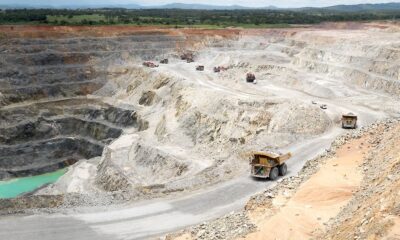
 Nyheter2 veckor sedan
Nyheter2 veckor sedanLundin Mining ska bli en av de tio största kopparproducenterna i världen


